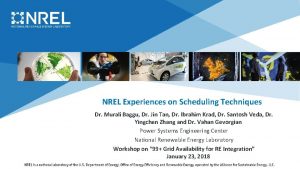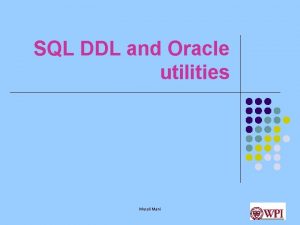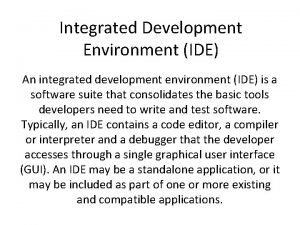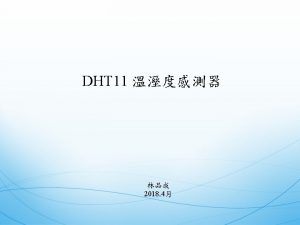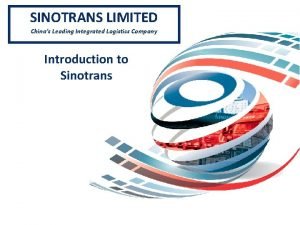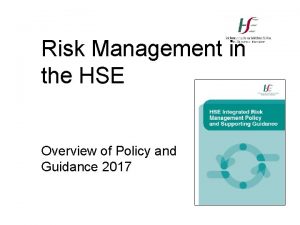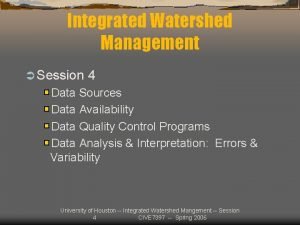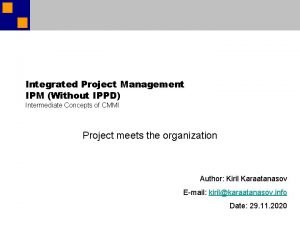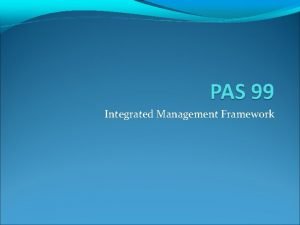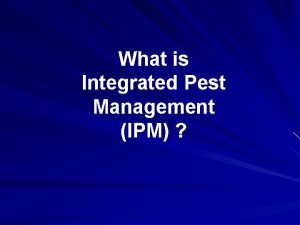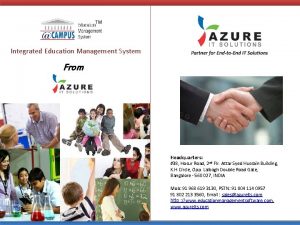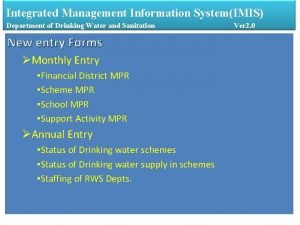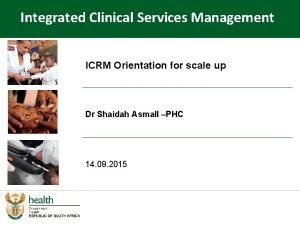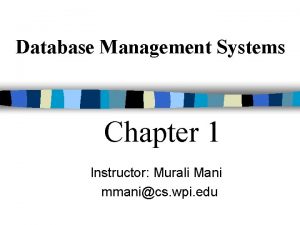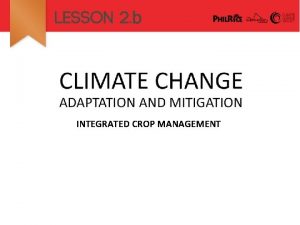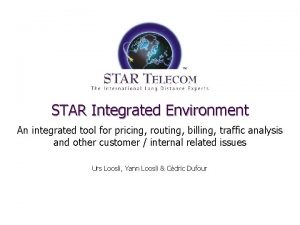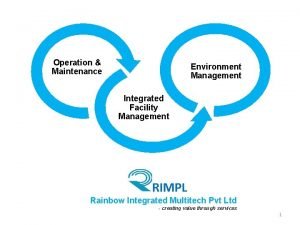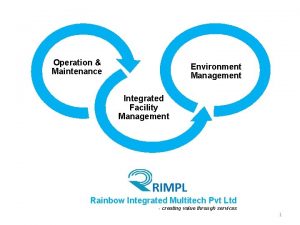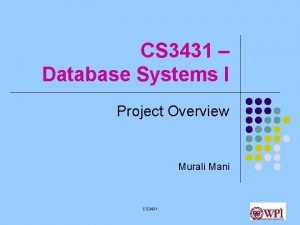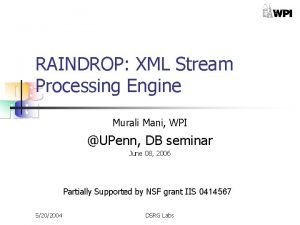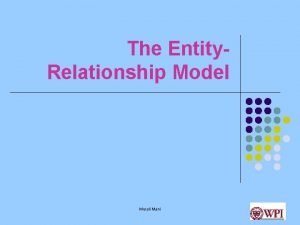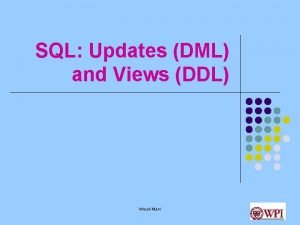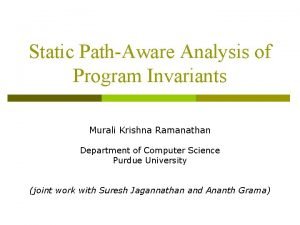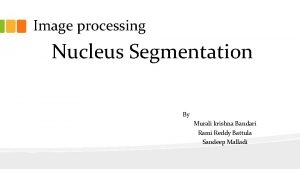Environment Management Integrated Environment ManagementIEM Dr Murali G

























- Slides: 25

Environment Management & Integrated Environment Management(IEM) Dr. Murali G. Ranjitkar Visiting fellow, NASC

Environment Management �Its an attempt to control human impact on and interaction with the environment in order to preserve natural resources �Environmental management focuses on the improvement of human welfare for present and future generation

Environment Management �Administrative functions that develop, implement and monitor the environmental policy of an organization �Optimal utilization of the finite resources between different possible uses. �Environmental criteria and economic considerations demand that such an allocation be efficient. (protection from degradation & protection for scarce and diminishing resources)

Environment Management �Perspectives on the Environmental Challenge �Examples of Environmental Aspects & Impacts �Three Key Environmental Issues �Environment-related Provisions General and Sect oral Acts �Importance of Environmental management

Environment Management As such �Protection of nature �Pragmatic resource conservation �Moral and aesthetic nature preservation �Environment and development

Integrated Environment Management(IEM) �Concept and principles of IEM �Goals of IEM �Benefits of IEM �Participants in IEM �Comparison TMA & IEMA �Principles and process of IEM

Perspectives on the Environmental Challenge

Examples of Environmental Aspects & Impacts

Three Key Environmental Issues ØThe world’s population continues to grow ØThe United Nations estimates that world population with grow from 5. 8 billion to 9. 4 billion by 2050 ØGlobal demand for food, water and other natural resources is rising ØCurrently, most natural systems are under stress ØThe earth’s climate is changing ØEvidence exists that a significant amount of the increase in temperature since the industrial revolution is caused by human economic activity

Environment-related Provisions General and Sectoral Acts �Environment Protection Act and Rules 1997 �Forest Act 1983 �Water Resource Act 1992 �Vehicle and Transport Management Act 1992 �Industrial Enterprises Act 1992 �Local Self Government Act 1992 �Electricity Act 1992 �Pesticides Act 1991

Importance of Environmental management �Improve management of environmental impacts �Set targets to reduce energy use, water use & waste to landfill �Initiate and maintain procedures to improve efficiencies �Define key responsibilities for achieving targets �Monitor and measure environmental performance against key indicators �Regularly assess progress towards achieving set objectives �Ensure due diligence and ongoing consideration of legal and other environmental requirements

Concept and principles of IEM �As a philosophy, IEM prescribes a code of practice for ensuring that environmental consideration are fully integrated into all stages of the development process in order to achieve a desirable balance between environment concern and development �Ecological complexity and interdependency of human and nature

Concept and principles of IEM �Functionally- IEM is management oriented approach to control environment disruption amidst the process of sustainable development �All action taken during project planning , implementation, and maintenance �It should be insure that non of their consequences are overlooked or underestimated

Concept and principles of IME �Sustainable and equitable development is combined with sound environment practice for healthy environment �Sustains people and nature �Provide protection for our unique resources �Result in an enhance quality of life for all

Goals of IEM �Objectives of IEM is �Ensure that development does not compromise environmental sustainability, health and safety and does not endanger natural and cultural resources �Ensure that the environmental consequences of the development proposals are understood and adequately considered in the planning, implementation and management of all development programmes

Goals of IEM �Establish a framework of cooperation between the government organization, the public sector, the private sector and the public so that sustainable development can take place �Stimulate responsible and justifiable decision making and action, and creative thinking in the planning and initial design stage

Goals of IEM �Guide the development process by implementing and encouraging the collection of objective information and reliable data with respect to environment related aspects and ensuring that it can be easily understood by all interested and affected parties in the development �Resolve or lessen any negative environmental impact and to enhance positive aspects of development proposals

Benefit of IME �Improved land productivity �Efficient water management �Biodiversity conservation �Conservation of natural resources �Enhance environment protection �Improve productivity and activities based on sustainable development

Participation in IEM �The community �Non governmental institutions �Industries �Local government

Comparison between TMA and IEMA Sector TNA IEMA Goal Economic growth higher productivity and profit shareholders wealth Sustainability and quality of life stakeholders welfare Values Anthropocentric, patriarchal values, rationality and packaged knowledge Centered around sustainable development concern Egalitarian and democratic values Intuition and understanding Products Designed for function style and price Wasteful packaging Design with concern for the environment Environment friendly packaging

Comparison between TMA and IEMA Organization Top-down decision making Centralized authority Participatory decision making Decentralised authority Environment Domination over nature Environment manage as resource Pollution and waste are external to the project Harmony with nature Resource regarded as strictly finite Pollution and waste elimination management Participation Owner, Manager, Worker Community, Institution, Industries, Local state and union government bodies, politician law maker etc Business function Marketing aims at increasing consumption Marketing for consumers education Finance aims at long

Principles and Process of IEM Principles �Pro-active planning �Informed decision making �An open and participatory approach �A broad understanding of the term environment �Accountability

Process of IEM �Development and assessment of the proposal �Decision on whether to accept the development project proposal or not �Implementation of projects

Major principles for implementation of IEM �Environment and economic integration �Maintenance of biological diversity and conservation of natural resources �Precaution, prevention and evaluate of human effects on environment �Cooperation, partnership and participation of communities �Educate, training and awareness generation of people

�Thank you
 Samaya murali irs
Samaya murali irs Malasala murali
Malasala murali Murali baggu
Murali baggu Murali sitaraman
Murali sitaraman Murali mani
Murali mani Dr murali krishna voona
Dr murali krishna voona Define integrated development environment
Define integrated development environment Procurement integrated enterprise environment
Procurement integrated enterprise environment Arduino development environment
Arduino development environment Integrated award environment
Integrated award environment Environment of business finance
Environment of business finance Performance cycle uncertainty
Performance cycle uncertainty Sinotrans air huawei
Sinotrans air huawei Risk register hse
Risk register hse Integrated watershed management
Integrated watershed management Faculty management system project report
Faculty management system project report Talent management scorecard
Talent management scorecard What is integrated service management
What is integrated service management Cmmi ipm
Cmmi ipm Integrated management framework
Integrated management framework Enterprise wide quality integrated management system
Enterprise wide quality integrated management system Integrated pest management objectives
Integrated pest management objectives Integrated educational information management system
Integrated educational information management system Power management integrated circuits
Power management integrated circuits Integrated management information system imis
Integrated management information system imis Integrated clinical services management
Integrated clinical services management


